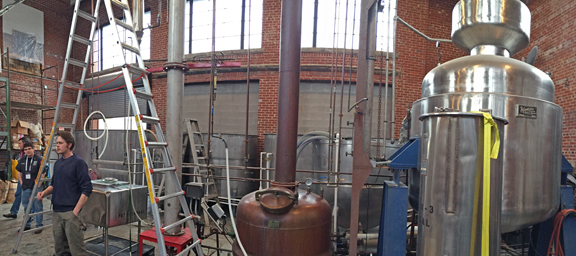Craft Beverages Unlimited added a new track to their trade show and conference in 2015. The distillery track was led by Mike Rasmussen from Painted Stave Distillery and Bill Owens from the American Distilling Institute. After introducing themselves Mike asked the attendees to tell about why they were here. There were several people that were starting or just opened a distillery. The largest group of attendees were winemakers that were looking to add distilling to what they were crafting.
Bill began the presentation by showing numerous photos of stills. He mentioned that purchasing stills is a long process. There is a waiting list of stills needed throughout the world. Some creative distillers build their own stills. Bill made a point that home-made still are usually small and it takes a lot of time to distill a few gallons. He suggests getting larger stills in order to distill larger quantities. The slides, of different types of stills, showed the wine variety of both commercial-made and home-made stills. Bill stated that if your distillery is large enough, you can entertain visitors. He poked fun at the wine and beer tourism industry. “At wineries you see stainless still tanks and barrels. At breweries, nobody understands what is happening. But at distilleries, we have copper.”
Bill talked about the desire that consumers have for visiting a farm distillery. Consumers like that grains and fruit are farmed on the land and eventually distilled. Bill talked about some of the differences between winemakers, brewers and distillers. “If you make a mistake in the distilling industry, you can re-distill. If you make a mistake in the beer or wine industry, you are dead.”
Mike Rasmussen from Painted Stave Distillery in Smyrna, Delaware spoke about his experience about distilling. Mike stated that it was illegal to have a distillery in Delaware. Mike crafted legislation to change the Delaware law to allow craft distilling. A few years later, he started Painted Stave Distillery. There was an old theater building in Smyrna that was abandoned. He was able to convert the building into a tasting room and production facility. The distillery produces Vodka, Gin and Whiskey. They also make a little grappa. The distillery focuses on local products. For example, local farms grow the botanicals used in the production of gin.
Mike runs most of his products through the still twice. He likes to run an item through the still as soon as fermentation is completed. Mike talked about a stripping run and the finishing run. heads and tails are removed during the second distilling run. He also removes some of the first heads collected during the first distilling run.
Miked spoke about creating partnerships with wineries and breweries. His distillery works with Harvest Ridge Winery for fruit, wine, pomace and barrels. A partnership with breweries includes sending whiskey barrels to the breweries. He also sources grain from breweries. Perhaps the most important partnership is working with tourism organizations on both state and county levels.
Regarding sales and marketing, Mike was amazed at how important the tasting room is. About 70% of his sales are from the tasting room, where visitors can taste the spirits straight or in a cocktail. Many of his guests have visited wineries or breweries, but visiting distilleries was new to them. Painted Stave Distillery offers an in-depth tour of the distillery where they explain the process.
Mike talked about different distilled products. Vodka is a distilled spirit at or above 95% alcohol (190 proof), and if bottled it is not less than 40% alcohol (80 proof). Vodka are distilled spirits that have been run through charcoal or other materiel or filtered. Gin is a spirit with a flavor derived from juniper berries and bottled an not less that 40% alcohol (80 proof). Brandy is distilled from fermented juice, mash or wine from its residue at less than 95% alcohol (190 proof). It has to be bottled at not less than 40% alcohol (80 proof). Grappa is a brandy. Whiskey is a spirit distilled from fermented mash of grain at less than 95% alcohol. Many types include Bourbon, Rye, Malt, Scotch, Irish, Canadian and others.
After the session about distilling, we visited the trade show where we had lunch, then boarded buses to visit two distilleries in Richmond. For the first time track at Craft Beverages Unlimited, the group enjoyed the visits to the two distilleries and discussions with the distillers. After the field trip we returned to the trade show and samples some distilled spirits.

We visited James River Distillery in Richmond, Virginia. Dwight Chew, head distiller, talked about the modifications he made to the distillery and the process he uses.
Cheers,
Terry




Leave a Reply